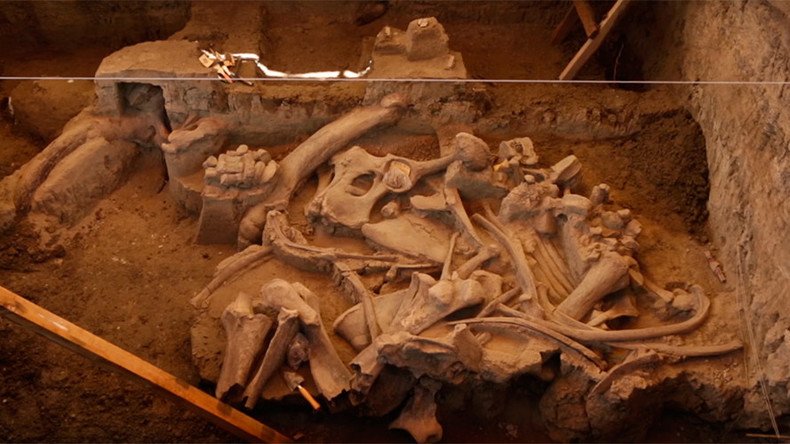Excavation of 14,000-yo mammoth reveals new information on ancient humans (VIDEO, PHOTOS)

The excavation of an enormous wooly mammoth, which lived between 12,000 and 14,000 years ago, may provide evidence that ancient humans lived in Mexico at the time.
Mexico's National Museum of Anthropology (INAH) say the bones of the prehistoric mammoth were discovered by chance in December 2015, during construction work near the town of Tultepec, approximately 40km north of Mexico City.
READ MORE: Scientists want to 'de-extinct' the woolly mammoth
Since the discovery, archaeologists have been painstakingly preserving the fossilized bones. Crucially, the mammoth was found cut up into pieces, which may indicate that prehistoric humans lived in Mexico 14,000 years ago.
Recuperan gran parte de la osamenta del mamut de Tultepec https://t.co/8gBW1qSXuj#INAH#paleontología#EdoMexpic.twitter.com/hlU97MIqMr
— INAHmx (@INAHmx) May 17, 2016
“We see the bones are mixed up; they are not in anatomical order,” Luis Cordoba, the archaeologist who is leading the project, told CNN Espanol.
“So analyzing them, you can reach the conclusion that it was partially cut up by hunters and gatherers at the time.”
El arqueólogo Luis Cordoba del @INAHmx con el mamut de Tultepec. Supuestamente se lo comieron los hombres primitivos pic.twitter.com/1YiYV9G83t
— pablo de llano (@pablodellano) May 20, 2016
“The discovery in Tultepec is important because it indirectly supports the presence of humans 14,000 years ago,” he concluded.
Testing has revealed that the mammoth was between 20 and 25 years old when it died. It is estimated to have weighed five tonnes and was 3.5 meters (11.5 feet) tall and five meters (16.5 feet) long. It belonged to the Columbian mammoth sub-species that roamed Central and North America.
Following restoration, the remains are expected to be put on public display, though the fragility of the bones means the process has to be carried out with great care.
READ MORE: Michigan farmer finds massive mammoth skeleton, donates it to university (VIDEO)
“We are talking about 14,000 years ago so it is a very considerable period of time. The effect [on the bones] over such a period is that the bones are very sensitive,” assistant archaeologist Felipe Munos said.
It was long believed that wooly mammoths were hunted into extinction by humans, but recent evidence suggests that the huge creatures were wiped out after the last ice age, as rising temperatures melted away their habitat.












